| Please Sign the Guestbook | You can read previous entries by clicking here | Archived "Latest News" | back to the KOS Homepage |
31/12/01 The cold, settled spell of weather has continued
over the Christmas holiday period with a minimum last night of -6ºC.
Surprisingly there seems to have been little in the way of any cold-weather
movement of birds. Pete Hall had a large flock of 1200 Fieldfares,500 Starlings
and 200 Redwings in Toft but that was
 almost three weeks ago and today
in Tatton no large concentrations were seen, just isolated Redwings in Dog Wood
grubbing amongst the leaf litter in the company of Blackbirds and Song
Thrushes. Things were also quiet for the annual Christmas walk around Great
Budworth, a figure-of-eight route of about 4½ miles, starting and ending
at the Anderton Lift car park, via Haydn's Pool and Budworth Mere. Highlight
was perhaps the small flock of Lesser Redpolls that gave close views as they
fed just above our heads in a roadside Silver Birch. At Budworth Mere the
viewing screen overlooking the feeding station has been completed and gives
good views of birds using the tables and hanging baskets, I believe this is a
good spot for Lesser Spotted Woodpecker but we saw none on our visit, perhaps
the approach path could be screened from view as the birds can see visitors
walking to the screen - which in some ways defeats it's purpose! The annual KOS
Christmas party took place this year on a Thursday for the first time and
attracted a good turnout of members, the food was well up to the standard we
have come to expect, it was excellent (especially of course the baked spuds!) -
and still only £4.50 a head! Together with Roy's bring and buy activities
a profit of £100 was made on the evening, enough to pay for a couple of
Speakers in the coming year! A Happy New Year and good birding from the
KOS!
almost three weeks ago and today
in Tatton no large concentrations were seen, just isolated Redwings in Dog Wood
grubbing amongst the leaf litter in the company of Blackbirds and Song
Thrushes. Things were also quiet for the annual Christmas walk around Great
Budworth, a figure-of-eight route of about 4½ miles, starting and ending
at the Anderton Lift car park, via Haydn's Pool and Budworth Mere. Highlight
was perhaps the small flock of Lesser Redpolls that gave close views as they
fed just above our heads in a roadside Silver Birch. At Budworth Mere the
viewing screen overlooking the feeding station has been completed and gives
good views of birds using the tables and hanging baskets, I believe this is a
good spot for Lesser Spotted Woodpecker but we saw none on our visit, perhaps
the approach path could be screened from view as the birds can see visitors
walking to the screen - which in some ways defeats it's purpose! The annual KOS
Christmas party took place this year on a Thursday for the first time and
attracted a good turnout of members, the food was well up to the standard we
have come to expect, it was excellent (especially of course the baked spuds!) -
and still only £4.50 a head! Together with Roy's bring and buy activities
a profit of £100 was made on the evening, enough to pay for a couple of
Speakers in the coming year! A Happy New Year and good birding from the
KOS!
21/12/01 During the Spring, because of the foot-and-mouth
restrictions, one important ornithological event that went unnoticed was the
nesting of a pair of Herons in Tatton Park for the first time.
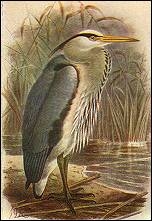 The nest was constructed in
Higmere Plantation close to the top of one of the waterside alder trees
opposite Dog Wood and was viewable only from there, by the time the
restrictions were lifted any young birds that had been reared were gone, but
judging by the appearance of the nest and it's surroundings it's entirely
possible that the attempt was successful. Herons are early nesters and a full
clutch of eggs will sometimes have been laid by the middle of February so
activity around the nest site begins around this time of year and earlier this
week a bird had taken up residence in the nest tree, presumably in early
preparation for the coming breeding season. Herons nest in colonies so this
first pair may eventually be joined by others, perhaps an overflow from the
eighty strong colony in Tabley Park a couple of miles to the south-west.
The nest was constructed in
Higmere Plantation close to the top of one of the waterside alder trees
opposite Dog Wood and was viewable only from there, by the time the
restrictions were lifted any young birds that had been reared were gone, but
judging by the appearance of the nest and it's surroundings it's entirely
possible that the attempt was successful. Herons are early nesters and a full
clutch of eggs will sometimes have been laid by the middle of February so
activity around the nest site begins around this time of year and earlier this
week a bird had taken up residence in the nest tree, presumably in early
preparation for the coming breeding season. Herons nest in colonies so this
first pair may eventually be joined by others, perhaps an overflow from the
eighty strong colony in Tabley Park a couple of miles to the south-west.
11/12/01 The Country has found itself under the influence
of some "continental" weather this week with an area of high pressure
reaching out over the North Sea to cover most of Great Britain. I find it
preferable to the usual junk blowing in from the Atlantic at this time of year,
temperatures at night are falling to around -2ºC and not creeping much
above freezing during the day, so once the inevitable mist finally lifts we're
left with a few hours of cloudless skies and unbroken sunshine to enjoy. Sunday
found us once again heading north, this time to the Southport area where the
low temperature combined with a brisk easterly wind confirmed that Marshside as
the coldest place on Earth! it was perishing, doubly so for Geoff and Sheila
just back from Madagascar where they "enjoyed" daytime temperature as
high as 40ºC - perhaps
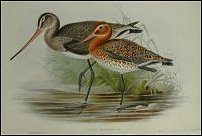 Marshside is not too bad after all! The
marshland in front of the two roadside hides was teeming with birds, mixed
flocks of Lapwings and Golden Plovers frequently took to the air, just how many
was difficult to judge but there must have been thousands of Lapwings and
hundreds of Golden Plovers. Other waders present included Curlew, Dunlin,
Redshank and Snipe together with good numbers of Black-tailed Godwits that gave
excellent views as they roosted a few yards from where we watched. Super views
also of the assembled wildfowl, Gadwall, Mallard. Teal, 100's Wigeon and many
examples of that most handsome of Ducks - the Pintail. Across at Martin Mere we
found a huge gathering of Wintering Swans, only 23 Bewick's but no less than
1400 Whoopers, a good percentage of these were birds of the year so they appear
to have enjoyed a successful breeding season. On the track down to the Millers
Bridge hide a male Brambling stood out well amongst a small flock of
Chaffinches and from the hide itself a Peregrine Falcon was picked out perched
on a distant fence post. The number of Pink-footed Geese proved to be a little
disappointing, normally when we visit Martin Mere at this time of year large
flocks are constantly on the move and very conspicuous commuting between the
Reserve and the surrounding farmland, this year they seemed to be outnumbered
by Greylags and well down in numbers. As dusk approached activity amongst the
Swans increased in anticipation of the daily feeding time when a wheel barrow
full of grain is distributed by the waters edge in front of one of the main
hides, the Whoopers were top of this particular pecking order but were
generally tolerant of the Geese and Ducks when they eventually plucked up
enough courage to eventually join in, they are not an aggressive species and
quite gregarious I don't think things would have been quite so civilised if we
had been talking about Mute Swans.
Marshside is not too bad after all! The
marshland in front of the two roadside hides was teeming with birds, mixed
flocks of Lapwings and Golden Plovers frequently took to the air, just how many
was difficult to judge but there must have been thousands of Lapwings and
hundreds of Golden Plovers. Other waders present included Curlew, Dunlin,
Redshank and Snipe together with good numbers of Black-tailed Godwits that gave
excellent views as they roosted a few yards from where we watched. Super views
also of the assembled wildfowl, Gadwall, Mallard. Teal, 100's Wigeon and many
examples of that most handsome of Ducks - the Pintail. Across at Martin Mere we
found a huge gathering of Wintering Swans, only 23 Bewick's but no less than
1400 Whoopers, a good percentage of these were birds of the year so they appear
to have enjoyed a successful breeding season. On the track down to the Millers
Bridge hide a male Brambling stood out well amongst a small flock of
Chaffinches and from the hide itself a Peregrine Falcon was picked out perched
on a distant fence post. The number of Pink-footed Geese proved to be a little
disappointing, normally when we visit Martin Mere at this time of year large
flocks are constantly on the move and very conspicuous commuting between the
Reserve and the surrounding farmland, this year they seemed to be outnumbered
by Greylags and well down in numbers. As dusk approached activity amongst the
Swans increased in anticipation of the daily feeding time when a wheel barrow
full of grain is distributed by the waters edge in front of one of the main
hides, the Whoopers were top of this particular pecking order but were
generally tolerant of the Geese and Ducks when they eventually plucked up
enough courage to eventually join in, they are not an aggressive species and
quite gregarious I don't think things would have been quite so civilised if we
had been talking about Mute Swans.
02/12/01 We came across a rare commodity during the week, a large field of stubble - complete with a fair range of birds, not in any great numbers but worth a further look later on in the Winter when we've had some frost and even a little snow. The location is at SJ793762 alongside Pinfold Lane in Marthall, on Friday there were c. 20 Chaffinches, 3 Yellowhammers, 5 Tree Sparrows and 25 Skylarks plus numerous Fieldfares and Redwings. A refurbished pond alongside the road was proving attractive to a mixed group of Mallards, Moorhens and a single Coot plus a handsome little Grey Wagtail that gave good views as it fed along the waters edge.
27/11/01 After a mild dry autumn only now are the trees finally shedding their leaves and there were some fine photo - opportunities yesterday in Tatton - reds, browns and yellows combining to give some splendid views throughout the Park. Also late this year are the Pink-footed Geese, for the past few years we've had flocks overflying the area from mid to late October but this year it wasn't until Saturday (24/11) that the first birds were seen over Knutsford, about 200 over the south of the town heading east through the Cheshire gap on their way to Norfolk. We lost a good friend on the 19th November with the death at the age of only 58 of Peter Haslam who suffered a heart attack the previous day and died in Wythenshaw Hospital the next morning. Peter had been a member of the KOS since the early days having joined in October 1974 and for many years was an "ever present" at both indoor and outdoor meetings, the Society was of course well represented at his funeral last Monday and all our condolences go out to Peter's Father and Brother.
20/11/01 Locally Tatton Park was one of the first places
to close during the foot and mouth epidemic and just about the last to re-open
as the threat diminished, local people often get the impression that visitors
to the
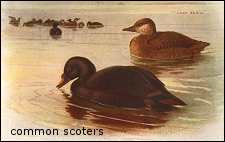 Park - especially those that
don't pay an entrance and/or parking fees ( this would include most birders who
come and go via the Dog Lodge entrance) - are considered a bit of an
inconvenience! I know of one local birder who was a major contributor of
records until this year who now concentrates his efforts and considerable
knowledge and experience elsewhere, citing the inconvenient opening and closing
times as one of the main reasons for his defection. With Gary Healy now living
"down South" somewhere Tatton is underwatched and lots of
"stuff" is going unrecorded, from this week the 8:00am opening time
has been reinstated so a few more observers may be encouraged to pay an early
morning visit on their way to work (or to get their Pensions, in the case of
KOS members!!). Paul Leigh and Dave Caveney popped in on Friday and were well
rewarded with a record count of 14 Common Scoters, quite rare inland and less
than annual in the Park, also present were 7 Shelduck and a female Stonechat
near the bathing area. The Scoters had moved on by the next morning but the
Shelduck were still there and in the dense foliage of the Higmere plantation
where it tumbles over into the water near the deer fence there were no less
than 21 Mandarin Ducks - mostly adult males, a vivid splash of colour to
brighten up a grey November day.
Park - especially those that
don't pay an entrance and/or parking fees ( this would include most birders who
come and go via the Dog Lodge entrance) - are considered a bit of an
inconvenience! I know of one local birder who was a major contributor of
records until this year who now concentrates his efforts and considerable
knowledge and experience elsewhere, citing the inconvenient opening and closing
times as one of the main reasons for his defection. With Gary Healy now living
"down South" somewhere Tatton is underwatched and lots of
"stuff" is going unrecorded, from this week the 8:00am opening time
has been reinstated so a few more observers may be encouraged to pay an early
morning visit on their way to work (or to get their Pensions, in the case of
KOS members!!). Paul Leigh and Dave Caveney popped in on Friday and were well
rewarded with a record count of 14 Common Scoters, quite rare inland and less
than annual in the Park, also present were 7 Shelduck and a female Stonechat
near the bathing area. The Scoters had moved on by the next morning but the
Shelduck were still there and in the dense foliage of the Higmere plantation
where it tumbles over into the water near the deer fence there were no less
than 21 Mandarin Ducks - mostly adult males, a vivid splash of colour to
brighten up a grey November day.
13/11/01 A wet start to the day for Sunday's trip over the Pennines to a new venue - Old Moor Wetland Center near Barnsley - the weather was atrocious as we drove along the A628 over Howden Moors but improved quickly as we dropped down towards Stocksbridge on the way to our final destination, by the time we arrived the rain and cloud was left behind and we enjoyed unbroken sunshine for the rest of the day. The Reserve covers 250 acres and seems to have been set up with the backing of the local Council who are apparently soon to transfer ownership to the RSPB who won't have to do much in the way of improvements, it really is already an excellent site, with a super Visitor Center complete with a shop, toilets and various "interpretive" facilities for school parties etc. There are 5 hides overlooking a range of habitats with wader scrapes, deeper lakes and areas of rank vegetation and hawthorn hedges, on the water were a good selection of wildfowl - we noted Wigeon in large numbers, Coot, Moorhen, Dabchick, Cormorant, Gadwall, Goldeneye, Teal, Mute Swan and Goosander, in the dryer areas were the waders, we counted around 600 Golden Plovers (but this total was well down on the 6,500 present until recently), Redshank, Dunlin and 3 Green Sandpipers. For many the highlight of the day was the number of Tree Sparrows on the Reserve - they were everywhere, the staff are encouraging this increasingly scarce species in everyway possible mainly by the use of nestboxes and by providing food in the form of corn spread under the Hawthorn hedges during the the Winter months. The success of these methods is self-evident with 21 pairs nesting this year and no less than 215 nestlings ringed shortly before leaving for the outside world!
07/11/01 The "Breeding Bird Atlas of Cheshire and
Wirral" reports only 10 tetrads with Ring Ouzels present during the
breeding season, with actual breeding confirmed in only 4 of these 2 kilometer
x 2 kilometer squares that
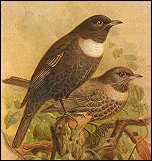 were used during the
survey to divide the county into 640 areas on which the 7 years of field work
were based. It's a shy moorland species, all the breeding records come from the
hills to the east of the County, lowland records from the Cheshire plain are
few and far between with only a handful of sightings each year during Spring or
Autumn passage. Given all this, together with the fact that the Ring Ouzel is a
Summer migrant, this week's bird in our Hon. Chairperson's garden in Mere is a
quite remarkable record so late in the season - the bird was a fine male and
spent most of Monday (5th) feeding on rowan berries with a mixed gathering of
Blackbirds, Redwings and Fieldfares. Sheila had a scope set up on it's
favourite tree so we all had excellent views of a species that normally an
average birdwatcher in Cheshire will now struggle to see on an annual basis,
and even if they do so it is normally only a fleeing glimpse as a bird drops
quickly away from view over a hill top along the Goyt Valley or
Wildboarclough.
were used during the
survey to divide the county into 640 areas on which the 7 years of field work
were based. It's a shy moorland species, all the breeding records come from the
hills to the east of the County, lowland records from the Cheshire plain are
few and far between with only a handful of sightings each year during Spring or
Autumn passage. Given all this, together with the fact that the Ring Ouzel is a
Summer migrant, this week's bird in our Hon. Chairperson's garden in Mere is a
quite remarkable record so late in the season - the bird was a fine male and
spent most of Monday (5th) feeding on rowan berries with a mixed gathering of
Blackbirds, Redwings and Fieldfares. Sheila had a scope set up on it's
favourite tree so we all had excellent views of a species that normally an
average birdwatcher in Cheshire will now struggle to see on an annual basis,
and even if they do so it is normally only a fleeing glimpse as a bird drops
quickly away from view over a hill top along the Goyt Valley or
Wildboarclough.
30/10/01 No sign in Tatton today of last week's Stonechats but a pleasant surprise in Dog Wood today with at least two Willow Tits moving through the trees in the company of a mixed flock of other Tits mainly Blue and Great, I believe that the pair that overwintered in the Shaw Heath area of Knutsford have been seen again feeding in the same garden as last Winter. A bird was present around the Haydn pool at Marbury during the late Summer although we haven't heard it during our last two visits (Hadyn Pool now seems to be the generally accepted name for what we used to call Marbury No1 Tank. [SJ658754] ). Another location where Willow Tits used to be found was the area containing the two disused sand quarries next to the M6 on the opposite side of the motorway to Shakerley Mere, a calling bird was heard above the traffic noise during a visit in late Summer, most of the open areas where Little Ringed Plovers used to nest have become overgrown and the emerging silver birches are providing plentiful nesting sites as branches and trunks die off for one reason or another.
22/10/01 More evidence during the past few days of the
steady descent (or change, depending on your point of view) into Winter
conditions. Four Bramblings in Toft on the 15th. arrived just about on the
average date we
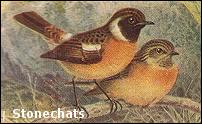 calculated for the KOS Bird Report of 1978, a time when there were
more of this species around in the Autumn and probably more active observers in
the area to record them. On Tatton Mere the ringed cormorant with it's red and
white ring, marked C4, has reappeared for at least it's fourth Winter in our
area, it spends most of it's time on the wire fence stretching across the mere
half-way through Dog Wood. Further up the mere a pair of Stonechats, a male and
female were discovered on the 19th by Paul Leigh and Dave Caveney, the male had
moved on the next day but the female was still present, moving with great
alacrity through the juncus reeds near the old "bathing area"
in search of insects - it was doing so very successfully and with a bit of luck
it may remain with us for a while yet - this is another of our declining
species.
calculated for the KOS Bird Report of 1978, a time when there were
more of this species around in the Autumn and probably more active observers in
the area to record them. On Tatton Mere the ringed cormorant with it's red and
white ring, marked C4, has reappeared for at least it's fourth Winter in our
area, it spends most of it's time on the wire fence stretching across the mere
half-way through Dog Wood. Further up the mere a pair of Stonechats, a male and
female were discovered on the 19th by Paul Leigh and Dave Caveney, the male had
moved on the next day but the female was still present, moving with great
alacrity through the juncus reeds near the old "bathing area"
in search of insects - it was doing so very successfully and with a bit of luck
it may remain with us for a while yet - this is another of our declining
species.
16/10/01 The first Fieldfares of the season today with 10
birds in Mobberley at 8am following a week of heavy Redwing passage noted in
Toft by Pete Hall who also had a late Swallow passing through this morning.
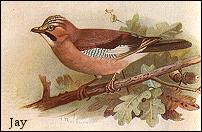 In Tatton a fine little Wheatear amongst a
small flock of Meadow Pipits gave excellent views as it rested close to the
"bathing area" before continuing with it's journey south. Jays are
very conspicuous in our local oak trees at the moment, filling their crops with
acorns before removing one last one - invariably held in the bill, then flying
off to a safe haven to stash them away for later retrieval as the weather gets
colder and other food resources dwindle.
In Tatton a fine little Wheatear amongst a
small flock of Meadow Pipits gave excellent views as it rested close to the
"bathing area" before continuing with it's journey south. Jays are
very conspicuous in our local oak trees at the moment, filling their crops with
acorns before removing one last one - invariably held in the bill, then flying
off to a safe haven to stash them away for later retrieval as the weather gets
colder and other food resources dwindle.
09/10/01 The Magnificent Seven
On Thursday October 4th 2001 a small intrepid band from
Knutsford Ornithologists arrived on Holy Island. Only seven in number but
representing the cream of the society they reached their Hotel, the
Lindisfarne. The weather forecast was not good but to dedicated birdwatchers
used to being out in all conditions this did not matter.
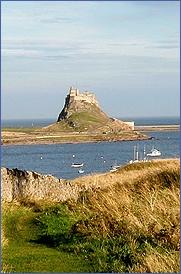 However on arrival
the weather was great and after a pleasant walk round the local birding spots,
followed by an excellent evening meal, they retired to the bar to plan the next
day's outing. Helped by liberal glasses of Isle of Skye whiskey the first
serious decision was reached, breakfast would be at 8.30 am. This slightly late
time would allow the party to have an early bird watch before breakfast. Friday
morning and perfect weather. Obviously we were hoping for strong easterly winds
followed by overcast conditions but we were determined not to let this unusual
weather deter us. After a slow walk round the island we reached our luncheon
rendezvous, Snipe Point. In past years many of our members have used this
opportunity to have a short nap, but not on this occasion. Binoculars and
Scopes were constantly searching the waves for those elusive birds often only
seen at this time of year though the numerous Stoats hunting in the rocks ahead
of us caused a slight distraction. After a couple of hours it was time to wend
our way back to the Lindisfarne but not before one of our members had carved
the date on the KOS tree trunk. A good evening meal and back to the bar for
another planning session. Saturday morning a more good weather. Another
excellent breakfast and it was out and about once again. After a hard morning
with no bush, tree or pool left unsearched it was only right that we allowed
ourselves a little relaxation so 3.00pm saw us in the lounge to watch the
England v Greece football match. A good result, which we duly celebrated that
evening. Starting at the Crown & Anchor then on to the Ship and finally
back to the Lindisfarne to finish the night with some more Isle of Sky whisky.
Sunday morning and time to leave. After saying farewell to Clive and Sue at the
Lindisfarne we set off on the journey home. It is always sad to leave. We have
been coming to Holy Island for 27 years and hopefully we will be coming for
many years to come. Good company, good weather and the odd bird had made it an
excellent trip. [JS]
However on arrival
the weather was great and after a pleasant walk round the local birding spots,
followed by an excellent evening meal, they retired to the bar to plan the next
day's outing. Helped by liberal glasses of Isle of Skye whiskey the first
serious decision was reached, breakfast would be at 8.30 am. This slightly late
time would allow the party to have an early bird watch before breakfast. Friday
morning and perfect weather. Obviously we were hoping for strong easterly winds
followed by overcast conditions but we were determined not to let this unusual
weather deter us. After a slow walk round the island we reached our luncheon
rendezvous, Snipe Point. In past years many of our members have used this
opportunity to have a short nap, but not on this occasion. Binoculars and
Scopes were constantly searching the waves for those elusive birds often only
seen at this time of year though the numerous Stoats hunting in the rocks ahead
of us caused a slight distraction. After a couple of hours it was time to wend
our way back to the Lindisfarne but not before one of our members had carved
the date on the KOS tree trunk. A good evening meal and back to the bar for
another planning session. Saturday morning a more good weather. Another
excellent breakfast and it was out and about once again. After a hard morning
with no bush, tree or pool left unsearched it was only right that we allowed
ourselves a little relaxation so 3.00pm saw us in the lounge to watch the
England v Greece football match. A good result, which we duly celebrated that
evening. Starting at the Crown & Anchor then on to the Ship and finally
back to the Lindisfarne to finish the night with some more Isle of Sky whisky.
Sunday morning and time to leave. After saying farewell to Clive and Sue at the
Lindisfarne we set off on the journey home. It is always sad to leave. We have
been coming to Holy Island for 27 years and hopefully we will be coming for
many years to come. Good company, good weather and the odd bird had made it an
excellent trip. [JS]
04/10/01 The Society's series of Autumn and Winter events
began in the traditional manner last Friday with an excellent turnout of almost
40 members and visitors for the 29th cine presentation by our friend from
Rochdale, Gordon Yates. Obviously benefitting from his recent retirement Gordon
was in ebullient form as he whisked us round the sea cliffs of the UK and up
and down the hills of his beloved Pennines, still sticking to the traditional
cine-film format and seemingly unimpressed by the possibilities offered by
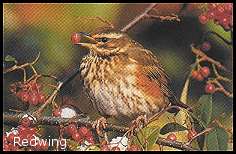 advances in video
equipment which would give the advantage of sound as well as vision - but then
again you can't give a presentation to a hall-full of people crouched round a
TV screen and as we all know an essential part of an evening with Gordon is his
enthusiastic commentary delivered in real time alongside the film. As a small
concession to current technology Gordon has set up a
Website where there
is an excellent display of his still images and the facility for online
ordering ( at remarkably low prices!) Last week's trickle of Meadow Pipits has
increased considerably, joined now by Skylarks with a heavy passage of both
species reported early this morning in Toft where Pete Hall recorded the first
Redwing of the autumn yesterday. Redwings migrate at night as well as during
the day, at this time of year try standing outside for a few minutes at night
especially in clear calm weather and you're almost certain to hear them calling
as the pass over at around 100' to 200' above ground.
advances in video
equipment which would give the advantage of sound as well as vision - but then
again you can't give a presentation to a hall-full of people crouched round a
TV screen and as we all know an essential part of an evening with Gordon is his
enthusiastic commentary delivered in real time alongside the film. As a small
concession to current technology Gordon has set up a
Website where there
is an excellent display of his still images and the facility for online
ordering ( at remarkably low prices!) Last week's trickle of Meadow Pipits has
increased considerably, joined now by Skylarks with a heavy passage of both
species reported early this morning in Toft where Pete Hall recorded the first
Redwing of the autumn yesterday. Redwings migrate at night as well as during
the day, at this time of year try standing outside for a few minutes at night
especially in clear calm weather and you're almost certain to hear them calling
as the pass over at around 100' to 200' above ground.
22/09/01 The Autumn equinox today and the nights are getting cooler, down towards freezing this week and it's had the usual effect on our swallows - they're off! On Friday at around 7:30am there were 18 on the electric cables running alongside Pavement Lane in Mobberley soaking up the early morning sun, they'd all gone today when we walked the same route. The wind has been coming in from the north and east for the past week and it has encouraged some early movement from further north, in Toft Pete Hall had a small flock of 6 Song Thrushes perched at the top of a Lime tree, typical of migrating Thrushes as opposed to local birds. He also reports a light passage of Meadow Pipits during the past few days, we've seen the same thing in Mobberley too.
12/09/01 The weather conditions over the weekend were
perfect for west coast birding with strong to gale force winds from the
north-west on Saturday and Sunday , observers weren't disappointed with 100's
of Shearwaters and Leach's Petrels being seen from favoured vantage points.
More than a dozen Sabine's Gulls were also seen - this is a "bogey"
bird for one of our most well known members and last weekend presented a real
opportunity for him to delete it form the top of his "most wanted"
list, unfortunately for him - and in the best traditions of the KOS - we chose
to go to Hilbre earlier this year and on what wasour traditional date
for a trip out to the Island - we were enjoying a couple of days on the EAST
coast! We began on Saturday at Fairburn Ings and on the advice of the Warden
made our way to the Lin Dike area of the Reserve,
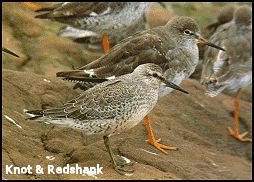 The hawthorn hedge
along the walk to the scrapes was full of migrating passerines Chiffchaff,
Garden and Willow Warblers, Blackcap and Common Whitethroat were all present in
good numbers. Hirrundines were passing through, mainly Swallows and Sand
Martins with a scattering of House Martins hawking for insects low over the
water and mud where an interesting collection of Waders were feeding, we noted
Green Sandpiper, Black-tailed Godwit, Dunlin, Little Ringed Plover, Redshank
and Greenshanks, an excellent start! From Fairburn we made our way across to
another RSPB Reserve at Blacktoft Sands on it's re-opening day after a month
long shutdown for maintenance including refurbishing the wader scrapes, they
seemed to have done a good job and from the hides we had splendid views of
Ruff, 19 Curlew Sandpipers, Water Rail, Little Stint and several Spotted
Redshanks. At one point the whole lot took to the air when a large female
Peregrine appeared on the scene and spent five minutes cruising round the
vicinity of the hides giving really amazing views. On Sunday after an overnight
stay in Withernsea we made the short journey
across to the Spurn Peninsula where we walked from the bottom end up to the
point with a gale force wind at our backs. A sea watch from the narrows
produced Wigeon, Gannet, Arctic and Great skuas plus Manx and Sooty
Shearwaters, but it was the waders that again made our day, as the tide ebbed
huge numbers flew along the shoreline Sanderling, Ringed Plover, Turnstone and
Knot, many of the latter still with traces of Summer plumage, seen in excellent
light battling against the wind over the grey, foam flecked waters of the
Humber estuary.
The hawthorn hedge
along the walk to the scrapes was full of migrating passerines Chiffchaff,
Garden and Willow Warblers, Blackcap and Common Whitethroat were all present in
good numbers. Hirrundines were passing through, mainly Swallows and Sand
Martins with a scattering of House Martins hawking for insects low over the
water and mud where an interesting collection of Waders were feeding, we noted
Green Sandpiper, Black-tailed Godwit, Dunlin, Little Ringed Plover, Redshank
and Greenshanks, an excellent start! From Fairburn we made our way across to
another RSPB Reserve at Blacktoft Sands on it's re-opening day after a month
long shutdown for maintenance including refurbishing the wader scrapes, they
seemed to have done a good job and from the hides we had splendid views of
Ruff, 19 Curlew Sandpipers, Water Rail, Little Stint and several Spotted
Redshanks. At one point the whole lot took to the air when a large female
Peregrine appeared on the scene and spent five minutes cruising round the
vicinity of the hides giving really amazing views. On Sunday after an overnight
stay in Withernsea we made the short journey
across to the Spurn Peninsula where we walked from the bottom end up to the
point with a gale force wind at our backs. A sea watch from the narrows
produced Wigeon, Gannet, Arctic and Great skuas plus Manx and Sooty
Shearwaters, but it was the waders that again made our day, as the tide ebbed
huge numbers flew along the shoreline Sanderling, Ringed Plover, Turnstone and
Knot, many of the latter still with traces of Summer plumage, seen in excellent
light battling against the wind over the grey, foam flecked waters of the
Humber estuary.
07/09/01 The
Witton
Limebedscontinue to give good value for money, on Tuesday we found that
only 2 Green Sandpipers remained on the Marbury No.1 tank but Snipe were
building up nicely with around 25 birds at the same location, also present were
a Ruff and a single Dunlin.
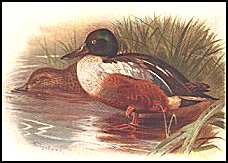 A late brood of Ruddy ducks swam
past the hide, Mum with 5 very small young following closely - manoeuvering
through a multitude of Little Grebes, no less than 21 of the latter were
counted on one recent occasion. Excellent views of the wildfowl from the hide,
most are still in eclipse plumage, of particular interest was a Shoveller that
was watched feeding just in front of us, it wasn't dabbling or
"up-ending" for food but diving, submerging completely below the
surface. This particular bird showed large areas of blue and green on it's
wings but no sign of the white chest and dark green head of a full adult male.
Looking at the original volume 1 of " Birds of the Western
Palearctic" a state of " supplementary" plumage mid-way between
eclipse and full breeding is described - in the more recent concise edition
this is described as "advanced eclipse" this was presumably the
plumage we observed on Tuesday -you learn something new every day!
A late brood of Ruddy ducks swam
past the hide, Mum with 5 very small young following closely - manoeuvering
through a multitude of Little Grebes, no less than 21 of the latter were
counted on one recent occasion. Excellent views of the wildfowl from the hide,
most are still in eclipse plumage, of particular interest was a Shoveller that
was watched feeding just in front of us, it wasn't dabbling or
"up-ending" for food but diving, submerging completely below the
surface. This particular bird showed large areas of blue and green on it's
wings but no sign of the white chest and dark green head of a full adult male.
Looking at the original volume 1 of " Birds of the Western
Palearctic" a state of " supplementary" plumage mid-way between
eclipse and full breeding is described - in the more recent concise edition
this is described as "advanced eclipse" this was presumably the
plumage we observed on Tuesday -you learn something new every day!
29/08/01 Splendid weather at the moment for raptors, two days ago I was thrilled to get a new "garden bird" (in my case I count anything seen from the premises!) the local House Martins suddenly became very agitated - a sure sign of trouble - and trouble it was in the unmistakable shape of a Hobby that shot through the middle of the flock scattering them in all directions. The Hobby appears to be "doing a Buzzard" and increasing in numbers exponentially, at one nearby location on the same day as I added to the garden list one observer had 5 Hobbies, 3 Buzzards and an immature Peregrine Falcon all in view at the same time - phew !!
20/08/01 This was our first August trip to Hilbre Island, normally it's September for our trek across the sands of the Dee, but we slotted this outing in to allow an Autumnal visit to the east coast next month. Things started badly though, we were only a short distance across to the islands when we came across three Dunlins that were in some distress - they were not injured in any way but were very weak and unable to fly, only capable of shallow fluttering wingbeats which gave us the opportunity to rescue them from the incoming tide. All three were found within 100 meters of each other and the consensus was that they were suffering from some sort of botulism, we handed them to the Island's ringers who had seen the same thing before, especially with gulls. There was plenty of avian activity on the Island, Swallows and Sand Martins were passing through all day, Terns were much in evidence, we had good views of Common, Arctic, Little and Sandwich they were attracting the attentions of Skuas which could be seen towards the horizon harassing the feeding terns, only one came close enough to be specifically identified, it was a Great Skua. Undoubted stars of the day were the waders - Dunlin, Oystercatchers, Redshanks, Ringed Plovers, Turnstones in good numbers plus a few Sanderlings and single Knot, Whimbrel and a Greenshank, the tide was a big one at 9.8 meters and from our vantage point near the slipway we had superb views of the roosting birds sitting out the tide on the red sandstone rocks no more than 50 feet from where we stood. To give an idea of the viewing conditions and proximity of the birds John took some pictures , I've put these on a separate page, they've "come out well" if that's the correct term to use with digital images with no latent image to come out of !! Those shot by holding the camera up to the eyepiece of a scope indicate what could (and is being) achieved using a proper adaptor.
15/08/01 One of the nicknames the French use for the Swift is "the hundred day bird" because that's the length of their stay during the Summer. We normally see the first birds over Tatton the last week in April with the bulk arriving back in early to mid-May, at the other end of the season most leave by the end of August, a September Swift whilst not rare would perhaps normally be remarked upon, having said that the Autumn of 1978 was memorable for it's late records, my notebook records the 26th. as the first time during that month that no Swifts were seen, but a flock of 60 were over Warford the next day - the 31st was the final date, 3 over Knutsford Moor. This month increasing numbers have been seen passing south most days, building up to the 11th when "many hundreds" were recorded by Derek Pike and Bob Groom over fields to the west of the town, interestingly there were none over Tatton at the same time. Our Mobberley Hobbies have re-appeared, there have been no records since early May until last night (14th.) when Paul Leigh and Dave Caveney came across a family party at the same location as last year. It may well be they've nested again but not been picked up due to restricted access during the foot-and-mouth epidemic.
10/08/01 House Sparrows seem to have enjoyed a successful breeding season judging by the substantial flocks currently being encountered in the hedgerows throughout the area, over the past few years they have struggled to reach double figures, but a flock in Mobberley today contained around 50 birds, most encouraging. Further down the same lane a Yellowhammer was still feeding young in the nest, they are double or even triple brooded around here, I once found an incubating bird in mid-August, all four eggs were completely white! Restrictions in Tatton Park have at last been lifted and it's once more possible to walk right round the main mere, there may be few takers from the ornithological fraternity many of whom are finding pastures new more rewarding at this time of the year.
03/08/01 Many people will know the location of the Woolston Eyes SSSI without
actually knowing it's identity - it's that huge area of wetlands visible from
the M6 lying to the west of the Thellwall Viaduct just before junction 21.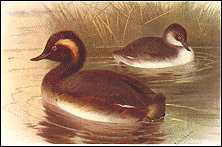 In beautiful Summer
weather we were given a conducted tour by Brian Martin, one of a team of
hardworking and dedicated volunteers who administer the Reserve, liaising with
numerous parties who have a controlling interest in the area and struggle to
restrict the activities of the usual gangs of vandals, car thieves and
druggies. It's status as a SSSI was gained because of it's importance as a
wintering area for wildfowl but more recently it's become Nationally important
because of the large number of breeding Black-necked Grebes, this year more
than 20 juveniles have been raised - a brood was still present on the evening
of our visit, part of a spectacular gathering of water birds, Mallard,
Shoveler, Pochard, Teal, Gadwall and Tufted Ducks - juvs. and eclipse adults,
quite a challenge! Around 80 pairs of Reed Warblers nest on the Reserve and no
less than 200 pairs of Sedge Warblers, they were predictably quiet at this time
of year but at regular intervals we could hear the characteristic reeling of
the resident Grasshopper Warblers emerging from deep within the rank
vegetation.
In beautiful Summer
weather we were given a conducted tour by Brian Martin, one of a team of
hardworking and dedicated volunteers who administer the Reserve, liaising with
numerous parties who have a controlling interest in the area and struggle to
restrict the activities of the usual gangs of vandals, car thieves and
druggies. It's status as a SSSI was gained because of it's importance as a
wintering area for wildfowl but more recently it's become Nationally important
because of the large number of breeding Black-necked Grebes, this year more
than 20 juveniles have been raised - a brood was still present on the evening
of our visit, part of a spectacular gathering of water birds, Mallard,
Shoveler, Pochard, Teal, Gadwall and Tufted Ducks - juvs. and eclipse adults,
quite a challenge! Around 80 pairs of Reed Warblers nest on the Reserve and no
less than 200 pairs of Sedge Warblers, they were predictably quiet at this time
of year but at regular intervals we could hear the characteristic reeling of
the resident Grasshopper Warblers emerging from deep within the rank
vegetation.
26/07/01 Well that's our 15 minutes of fame over with, it certainly had a positive effect on the site's hit counter ! Roger is writing up the story with a view to having it published in one of the "glossies" - he's also doing a description for submission to the Rarities Committee. The expansion of the breeding range of the Little Egret continues, we paid a visit to Frodsham Marshes where a pair nested this year in a partly submerged Hawthorn bush on the Number 6 tank. There was no sign of the adult birds but the single young bird was perched close to the nest site and gave excellent views. Also present were a huge number of Black-tailed Godwits, 1400 had been counted earlier in the week - this is a superb location and would make an excellent reserve for the RSPB, when they've run out of obscure patches of Scottish moorland to buy.
17/07/01 Congratulations to Roger
Barnes on earning his place in British Ornithological history with this superb
photo of a Red-billed Tropicbird taken on Thursday 7th June 2001
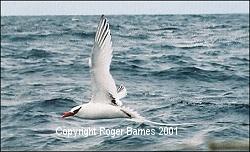 20 miles SSE of the
Scillies whilst Roger and friends were on passage from the Scillies to
Dournenez in France aboard the Marg a Rita. This will be a first ever record
for the United Kingdom if accepted by the
British
Birds Rarities Committee The assessment process is rigorous, especially for
a "First for Britain claim" but with such an unmistakable species
combined with Roger's excellent picture, availability of the original negative
and the ships log book (Roger was Skipper) there appears no reason why this
record won't be accepted by the committee.
20 miles SSE of the
Scillies whilst Roger and friends were on passage from the Scillies to
Dournenez in France aboard the Marg a Rita. This will be a first ever record
for the United Kingdom if accepted by the
British
Birds Rarities Committee The assessment process is rigorous, especially for
a "First for Britain claim" but with such an unmistakable species
combined with Roger's excellent picture, availability of the original negative
and the ships log book (Roger was Skipper) there appears no reason why this
record won't be accepted by the committee.
14/07/01 Excellent weather today for the trip to
Llandudno and Conway, cool but mainly blue skies and no rain. We began in
Llandudno, making our way up the Great Orme via the road alongside the
tramway,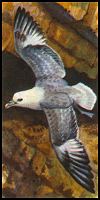 turning right at the
halfway station and then walking down past St. Tudno's church to the Marine
Drive which we used to make our way back up, past the old lighthouse as far as
the appropriately named "Rest & be Thankful" cafe on top of the
cliffs overlooking the island of Anglesey. The ledges on the cliff face below
the lighthouse housed numerous nesting auks, mainly Razorbills and Guillemots,
there was much activity with adult birds flying in and out in constant steams,
good numbers of Fulmars and Kittiwakes were noted perhaps one of these was the
target for a Peregrine Falcon that gave such beautiful views as it flashed past
within a few yards of where we stood before vanishing so quickly down and away
over the cliff top. After a break at the excellent little cafe we turned east
onto the "limestone pavement" back to the area above the churchyard,
encountering on the way Meadow pipits, Skylarks, Linnets and no less than four
pairs of Stonechat with well grown families, the adult birds noisily
complaining at our intrusion with their characteristic alarm calls. Back at the
Conway RSPB Reserve things were very quiet although as the tide was coming in a
small party of waders formed containing Dunlin, Redhank and six Black-tailed
Godwits, two of which were in almost full summer plumage.
turning right at the
halfway station and then walking down past St. Tudno's church to the Marine
Drive which we used to make our way back up, past the old lighthouse as far as
the appropriately named "Rest & be Thankful" cafe on top of the
cliffs overlooking the island of Anglesey. The ledges on the cliff face below
the lighthouse housed numerous nesting auks, mainly Razorbills and Guillemots,
there was much activity with adult birds flying in and out in constant steams,
good numbers of Fulmars and Kittiwakes were noted perhaps one of these was the
target for a Peregrine Falcon that gave such beautiful views as it flashed past
within a few yards of where we stood before vanishing so quickly down and away
over the cliff top. After a break at the excellent little cafe we turned east
onto the "limestone pavement" back to the area above the churchyard,
encountering on the way Meadow pipits, Skylarks, Linnets and no less than four
pairs of Stonechat with well grown families, the adult birds noisily
complaining at our intrusion with their characteristic alarm calls. Back at the
Conway RSPB Reserve things were very quiet although as the tide was coming in a
small party of waders formed containing Dunlin, Redhank and six Black-tailed
Godwits, two of which were in almost full summer plumage.
*** Breaking News*** During Saturday's trip it was
revealed that an ex-member of the KOS who still attends meetings a couple of
times each year on a casual basis recently saw an unusual looking bird which he
successfully managed to photograph. From this it is apparent that this wasn't
just an "unusual" sighting, nor was the bird merely rare or even very
rare - it's only a first ever record for Britain!!!! More details as
they become available.
7/07/01 A long slog up and over Alderley Edge mid-week on
a very hot day with the Thursday
Group produced little in the way of birds although the wide range of
flowers and magnificent views from "The Edge" were ample
compensation.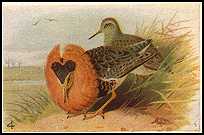 By way of a change, a
visit today to The Witton Limebeds ,
specifically the Marbury number one tank, now sporting two new (and as yet
un-vandalized) viewing screens - one with a roof and seating. There was a
certain amount of song with Blackcap, Chiffchaff, Reed Warbler and Common
Whitethroat all heard intermittently during the afternoon, plenty of juvenile
birds were noted especially Coot and Moorhens together with at least 3 broods
of Little Grebes. 3 Green Sandpipers were feeding at the waters edge alongside
a Ruff still showing a lot of Summer plumage with a white neck, black flanks
and a chestnut coloured back, the Birdnet news page reports that by this
evening no less than 10 Sandpipers were present plus an additional Ruff.
By way of a change, a
visit today to The Witton Limebeds ,
specifically the Marbury number one tank, now sporting two new (and as yet
un-vandalized) viewing screens - one with a roof and seating. There was a
certain amount of song with Blackcap, Chiffchaff, Reed Warbler and Common
Whitethroat all heard intermittently during the afternoon, plenty of juvenile
birds were noted especially Coot and Moorhens together with at least 3 broods
of Little Grebes. 3 Green Sandpipers were feeding at the waters edge alongside
a Ruff still showing a lot of Summer plumage with a white neck, black flanks
and a chestnut coloured back, the Birdnet news page reports that by this
evening no less than 10 Sandpipers were present plus an additional Ruff.
27/06/01 Local residents, many from Knutsford but especially those in Mobberley, fought long and hard to prevent the spread of Manchester Airport into the heart of the village during the public enquiry into the building of the infamous "runway 2". Unfortunately it was all to no avail and the new stretch of concrete was opened in February this year, projecting 1½ miles south west, directly towards the centre of Knutsford. Probably as a result of the reaction against the plan the airport has spent hundreds of thousands of pounds on landscaping projects around the perimeter of the new runway, no expense has been spared and although this work won't reduce the noise inflicted on local residents the wildlife is prospering and appears not to be affected by the air traffic. We have made numerous visits over the past few weeks to the area, although many of the new paths and bridleways have been closed due to foot-and-mouth restrictions and remain unexplored - Blackbirds, Song Thrushes and Chaffinches were present in large numbers along the west side of Wood Lane whilst the low scrub springing up along the top of the newly excavated water courses was proving attractive to both Common Whitethroats and Linnets. The most obvious beneficiaries were Skylarks attracted by the acres of fresh green grass 200 yards wide growing alongside the whole two mile length of R2, they were singing at their usual height, often higher than the landing jets, but seemed to know that as long as they remained over the grass and didn't stray over the tarmac all would be well!
19/06/01 Despite the return to cooler, unsettled weather
over the past two weeks our local Blue Tits seem to have fledged successfully
and family parties
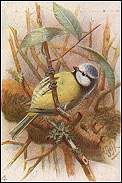 can currently be met with
throughout the area. Among them our "own" brood who's safety was
being threatened shortly before fledging by the attentions of a large black cat
that was stationed in the tree a few inches from the nest box waiting for the
parents to return with food, fortunately when in this mode cats seem to
concentrate solely on the job in hand and become oblivious to any peripheral
activity and I was able to approach from behind and pursue a zero tolerance
policy. We've not seen it since. Blue Tits are single brooded so that's their
breeding season finished until next Spring, others are continuing with further
broods and seem to begin singing again at this time of year, Song Thrushes and
Lesser Whitethroats have been very prominent this week.-
can currently be met with
throughout the area. Among them our "own" brood who's safety was
being threatened shortly before fledging by the attentions of a large black cat
that was stationed in the tree a few inches from the nest box waiting for the
parents to return with food, fortunately when in this mode cats seem to
concentrate solely on the job in hand and become oblivious to any peripheral
activity and I was able to approach from behind and pursue a zero tolerance
policy. We've not seen it since. Blue Tits are single brooded so that's their
breeding season finished until next Spring, others are continuing with further
broods and seem to begin singing again at this time of year, Song Thrushes and
Lesser Whitethroats have been very prominent this week.-
11/06/01 Typical conditions over the weekend for our trip
to Leighton Moss, single figure temperatures, heavy squally showers and a
biting wind sweeping in from the west across Morecambe Bay.
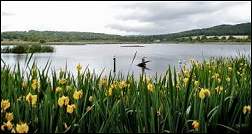 Typical that is for
when we normally visit the Reserve in early Spring, but we were only two weeks
away from the longest day and forced into full Winter gear once again! Most
species would have been feeding young, and must have been struggling to find
any form of insect life, Swifts and all three hirrundines were around in good
numbers forced low over the reeds and surface of the water in search of
sustenance, no Bearded Tits were seen although a notice in the reception
building was asking for all sightings of this species to be reported, so
perhaps they're currently having a hard time. The photo shows the view from the
public hide from where Bitterns were heard "booming" and a pair of
Great Crested Grebes were watched feeding young that were still being carried
on the back of one of the parents. On the return journey we visited what was
for us a new location at Sunderland Point where the
River Lune empties into Morecambe Bay, it was reminiscent of the journey across
the causway to Lindisfarne - the point is cut off at high tide and visits have
to be timed accordingly. It was obviously the wrong time of year for us but
could prove productive during the Autumn, Winter or earlier in the Spring, it's
easy to get to and we'll give it another try sometime.
Typical that is for
when we normally visit the Reserve in early Spring, but we were only two weeks
away from the longest day and forced into full Winter gear once again! Most
species would have been feeding young, and must have been struggling to find
any form of insect life, Swifts and all three hirrundines were around in good
numbers forced low over the reeds and surface of the water in search of
sustenance, no Bearded Tits were seen although a notice in the reception
building was asking for all sightings of this species to be reported, so
perhaps they're currently having a hard time. The photo shows the view from the
public hide from where Bitterns were heard "booming" and a pair of
Great Crested Grebes were watched feeding young that were still being carried
on the back of one of the parents. On the return journey we visited what was
for us a new location at Sunderland Point where the
River Lune empties into Morecambe Bay, it was reminiscent of the journey across
the causway to Lindisfarne - the point is cut off at high tide and visits have
to be timed accordingly. It was obviously the wrong time of year for us but
could prove productive during the Autumn, Winter or earlier in the Spring, it's
easy to get to and we'll give it another try sometime.
5/06/01 Despite continuing sporadic outbreaks of foot and mouth disease, including cases in High Legh and Rainow, many Cheshire footpaths were re-opened over the weekend, this gave us the chance to visit the Fox Harbour area of Mobberley for the first time since February. It was disappointing with relatively little activity and very few birds, two pairs of Yellowhammers were feeding young and a third male was heard in song, three Linnets were recorded but there was no evidence of nesting and only a single Skylark was singing along the route we took. Of the Summer visitors three Chiffchaffs and a Blackcap were singing but there was neither sight nor sound of any Willow Warblers all morning - but all wasn't doom and gloom! at Gleave House Farm there appeared to be an abundance of Swallows and on the return journey there were clouds of Swifts and House Martins over Mobberley SQ. At one stage I counted no less than 14 Martins collecting mud from the margins of the lake, are some of these from Toft? Pete Hall has only 1 pair this year compared to up to 60 in recent years! This was only the first visit to this part of Mobberley this Summer so things can obviously improve over the next few weeks but we have already lost April and May, the best two months of the year.
28/05/01 Our long Spring weekend
this year found us on the Welsh coast, based for three nights at the seaside
resort of Barmouth. Roy's choice of accommodation is always good, but this time
he really came up trumps in choosing the Wavecrest Hotel.
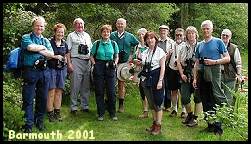 Run by Eric and
Shelagh Jarman and overlooking the sea the hotel has only 9 rooms but boasts an
impressive wine list and an even bigger line-up of malt whiskies, these,
combined with Shelagh's superb cooking produced a weekend that will long be
remembered (especially those who chose to mix the grain and grape on the
final evening)! 16 members made their way in small groups to Barmouth, we
chose to travel via Lake Vyrnwy where we found some hides and a pleasant
woodland walk reopened as the foot-and-mouth restrictions are gradually eased.
Both Spotted and Pied Flycatchers were feeding young, the latter being the most
numerous, also singing from the oakwoods were Tree Pipits and Redstarts whilst
from the distant moorland a Cuckoo was calling, a first for the year for some
people (who really should get out more!!). The feeder next to the window in the
small public hide next to the car park produced beautiful views of Siskins as
they fed on the peanuts provided, no more than 6 " from the glass.
Run by Eric and
Shelagh Jarman and overlooking the sea the hotel has only 9 rooms but boasts an
impressive wine list and an even bigger line-up of malt whiskies, these,
combined with Shelagh's superb cooking produced a weekend that will long be
remembered (especially those who chose to mix the grain and grape on the
final evening)! 16 members made their way in small groups to Barmouth, we
chose to travel via Lake Vyrnwy where we found some hides and a pleasant
woodland walk reopened as the foot-and-mouth restrictions are gradually eased.
Both Spotted and Pied Flycatchers were feeding young, the latter being the most
numerous, also singing from the oakwoods were Tree Pipits and Redstarts whilst
from the distant moorland a Cuckoo was calling, a first for the year for some
people (who really should get out more!!). The feeder next to the window in the
small public hide next to the car park produced beautiful views of Siskins as
they fed on the peanuts provided, no more than 6 " from the glass.
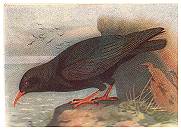 Our main destination
on the Friday was the RSPB's reserve at Ynys-hir where again not all the
Reserve was accessible but a delightful woodland walk had been reopened, we
added to an ever increasing trip list but more importantly it was here that
everyone got such excellent views of singing Wood Warblers, Pied Flycatchers,
Blackcaps and Garden Warblers. We returned to Barmouth along the coast road
taking a detour at Tywyn to "Bird Rock" an isolated monolith which
must be around 200' high and despite being 5 miles from the coast is a home for
nesting Cormorants and Chough. There seemed to be a number of pairs of Chough
and they gave good views both in flight and whilst perched high above us on
their nesting ledges. Early risers on Saturday were rewarded with Manx
Shearwaters in the distance over Barmouth Bay and Dolphins close enough to be
specifically identified from the promenade. After breakfast we made our way to
Penmaenpool and after a complicated logistical exercise arranged the transport
so that we were able to enjoy a one way walk of 6 miles alongside the Mawddach
Estuary on the disused railway line. Good numbers of Warblers were again in
song, this time including many Sedge Warblers that gave excellent views as they
sang from the trackside reed beds. More Cuckoos were heard and both Stonechats
and Sand Martin were recorded for the first time as we made our way slowly
along with the usual frequent stops as the KOS (botanical) Section came across
another group of plants that needed to be identified and enthused over! We
recorded 83 species during the weekend including Hen Harrier, Merlin and Osprey
who's actual locations we've chosen not to reveal; this was a super weekend -
good birds, good company and excellent accommodation.
Our main destination
on the Friday was the RSPB's reserve at Ynys-hir where again not all the
Reserve was accessible but a delightful woodland walk had been reopened, we
added to an ever increasing trip list but more importantly it was here that
everyone got such excellent views of singing Wood Warblers, Pied Flycatchers,
Blackcaps and Garden Warblers. We returned to Barmouth along the coast road
taking a detour at Tywyn to "Bird Rock" an isolated monolith which
must be around 200' high and despite being 5 miles from the coast is a home for
nesting Cormorants and Chough. There seemed to be a number of pairs of Chough
and they gave good views both in flight and whilst perched high above us on
their nesting ledges. Early risers on Saturday were rewarded with Manx
Shearwaters in the distance over Barmouth Bay and Dolphins close enough to be
specifically identified from the promenade. After breakfast we made our way to
Penmaenpool and after a complicated logistical exercise arranged the transport
so that we were able to enjoy a one way walk of 6 miles alongside the Mawddach
Estuary on the disused railway line. Good numbers of Warblers were again in
song, this time including many Sedge Warblers that gave excellent views as they
sang from the trackside reed beds. More Cuckoos were heard and both Stonechats
and Sand Martin were recorded for the first time as we made our way slowly
along with the usual frequent stops as the KOS (botanical) Section came across
another group of plants that needed to be identified and enthused over! We
recorded 83 species during the weekend including Hen Harrier, Merlin and Osprey
who's actual locations we've chosen not to reveal; this was a super weekend -
good birds, good company and excellent accommodation.
23/05/01 The local Lapwings must have been optimistic about getting through the breeding season without interruption due to the state of the ground and the difficulty the farmer was having gaining access. They nearly made it, but during the past week or so the land has been ploughed and today was being sowed with barley, quite late but as long as any mildew is treated the farmer was relatively optimistic about success . Fortunately most of the Lapwing chicks were well advanced and seemed to move out of the way as tractor approached, although on one occasion a smaller youngster stayed put but was noticed by the driver who dropped down from the cab and gently moved it a few yards to one side onto a section he'd just ploughed. No Grey Partridge here in what was a local stronghold, they have been replaced by (presumably) the introduced Red-legged variety (Alectoris rufa), three pairs were very active the other evening at dusk during an unsuccessful search for "roding" Woodcock, dashing at great speed across emerging fields of spring sown barley uttering all sorts of weird calls, they're very interesting and attractive birds but their confiding nature perhaps reveals their origins and I think we'd all prefer it if our own shy and retiring Greys reappeared.
16/05/01 As predicted the Birdguides rare bird information facility is no longer completely free, a basic version remains f.o.c. but an annual fee is payable for the full ( and much enhanced) service. I took advantage of the introductory offer of only £10 pa - <20p a week, the eventual cost will still be only £15 and it does seem good value, not only for the up to the minute news of rarities but for access to archived information from previous days. The underlying database is very impressive and as records are added over the years it will become a useful tool for those interested in the analysis of the data, assuming they are retained and made generally available. I looked up the records for Black Tern this Spring, these showed a build up from the 10th of May reaching a peak on the14th coinciding nicely with 4 birds seen over Tatton along with 3 Common Terns. What were presumably the same 3 birds were present yesterday but by this morning they had moved on, being replaced by an obliging Black Tern that arrived with the sunshine in mid-morning and showed well close to the shore in front of Dog Wood. Another welcome stranger, a Greenland Wheatear(O.o.leucorhoa) appeared last evening in a field bordering Pavement Lane in Mobberley, this too had moved on by early morning, on to the North, to the Arctic Circle and beyond.
14/05/01 The late night weather
forecaster predicted euphemistically that the coming week's weather would be
" good for growing". He seems to have got it right so far, since
midnight we've had over an inch of precipitation
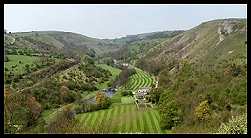 in the
form of a heavy drizzle after a week with no rain at all; the weekend weather
was excellent with almost unbroken sunshine and temperatures into the high
20's. Sunday found us in Derbyshire along a route planned by John - starting at
Miller's Dale and then following the course of the River Wye for about 5 miles
to Monsal Head, this all sounds very energetic, but not so because the path
uses long stretches of a disused railway and is thankfully level except for a
short stretch at the end as it climbs up about 200' to the Monsal Head pub (
top photo).
in the
form of a heavy drizzle after a week with no rain at all; the weekend weather
was excellent with almost unbroken sunshine and temperatures into the high
20's. Sunday found us in Derbyshire along a route planned by John - starting at
Miller's Dale and then following the course of the River Wye for about 5 miles
to Monsal Head, this all sounds very energetic, but not so because the path
uses long stretches of a disused railway and is thankfully level except for a
short stretch at the end as it climbs up about 200' to the Monsal Head pub (
top photo).
 The first bird of the
day was a splendid male Redstart which gave excellent views as it sang from an
Ash tree close to the station at Miller's Dale, we were to see and hear many at
regular intervals along the whole length of the route. No shortage of Willow
Warblers here! they were everywhere and I don't think we were out of earshot of
a singing male all morning, well concealed Garden Warblers seemed to outnumber
Blackcaps in this part of the world, whilst at least half a dozen equally
elusive Pied Flycatchers could be heard from the trackside foliage. A splendid
walk ended at the picture postcard village of Ashford-in-the-water (bottom
photo) where we lunched by the riverside before heading for home across the
Pennines.
The first bird of the
day was a splendid male Redstart which gave excellent views as it sang from an
Ash tree close to the station at Miller's Dale, we were to see and hear many at
regular intervals along the whole length of the route. No shortage of Willow
Warblers here! they were everywhere and I don't think we were out of earshot of
a singing male all morning, well concealed Garden Warblers seemed to outnumber
Blackcaps in this part of the world, whilst at least half a dozen equally
elusive Pied Flycatchers could be heard from the trackside foliage. A splendid
walk ended at the picture postcard village of Ashford-in-the-water (bottom
photo) where we lunched by the riverside before heading for home across the
Pennines.
11/05/01 The last of our "benchmark" species and the first Garden Warbler of the year duly appeared yesterday on Knutsford Moor. One of 10 species that occur annually each Spring in sufficient numbers to make year on year analysis of data a valid exercise. The other nine are Sand Martin, Swallow, House Martin, Swift, Chiffchaff, Willow Warbler, Blackcap, Reed Warbler and Cuckoo. Although the Cuckoo is on shaky ground at the moment and could end up going the way of the Yellow Wagtail, Common Sandpiper, lastminute.com and Manchester City - candidates for promotion include Lesser Whitethroat and Hobby ! The Society was well represented at last night's meeting called by the Cheshire Conservation Trust to discuss the future of Knutsford Moor, bits of the Moor are owned by Macclesfield Council, North West Water and Randle Brooks and agreement has been reached that the Trust will run it as a Nature Reserve. The discussion lasted 90 minutes and was quite wide ranging due to the audience being split between "conservationists" and local residents who had gone along for a good whinge about litter and vandalism. Nevertheless it was all very civilised and well handled, the Trust will consider everyone's input and suggestions, eventually producing an action plan after carrying out a comprehensive site survey. This should take about 12 months and will give plenty of opportunity for local input, including practical work for those interested in learning a little about reed bed management. The Moor is in good hands.
07/05/01 On Saturday evening during a two hour period I walked two local routes. The first in Mobberley took me along the whole length of Breech House Lane from it's junction with Altrincham Road right through to the boundary with Manchester Airport, the second, an old favourite, along the east side of Knutsford Moor and on through Dog Wood to the security fence. At this time of year I would have expected plenty of Willow Warblers: there were none, not a single bird was heard. Thinking it may have been the time of day and relatively cool conditions, I repeated the two routes today, blue sky and 20ºC, still not a Willow Warbler to be heard, they have returned, I heard two on the Moor on 23 April and one in Mobberley two days later - but since then nothing. The weather today really was excellent and in the thermals over Toft Pete Hall had good views of a pale phase Honey Buzzard together with two other unidentified large raptors!
04/05/01 Tatton Park partially re-opened to the public this week, some records have been added to the logbook by the Rangers during the closure, of special interest are the April records of Osprey and Common Terns. The Knutsford gate opens tomorrow allowing pedestrian access although a full circuit of the main Mere won't yet be possible because the gate in Dog Wood will be kept locked. In theory access to Dog Wood is for some strange reason not allowed, but the tape and warning notices have vanished and the dog walkers will no doubt reclaim it this weekend. An e-mail from Bryan Roberts gives details of two good records from Wednesday (2nd) both on Knutsford Moor, the first Cuckoo and a "reeling" Grasshopper Warbler, a Cuckoo was present tonight but no sign of the "Gropper". Across the Park near the Hall a Pied Flycatcher apparently gave good views this morning, it could do with moving to Dog Wood were Keith's nest boxes, specially erected for this species have remained unused so far. An extra trip has been included in this months programme - Sunday the 13th. - venue to be decided on the day - meet at 8:30am at the Sessions House.
02/05/01 An excellent day yesterday with no less than
four summer visitors putting in a first (recorded) appearance this year. In
Toft Pete Hall had a fine male Wheatear
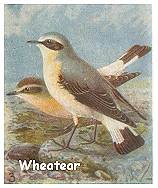 exploring a rabbit hole, in
theory a likely nesting location for the species, although this would be
unusual, but not unknown on the Cheshire plain. On Knutsford Moor a cock Common
Whitethroat was showing well as it sang loudly from the top of a bramble patch
near the railway bridge, but the first Sedge Warbler was reluctant to show
itself although we were only a few yards from where it was singing, hidden in
the reed bed. No problems earlier in the day along Breech House Lane in
Mobberley where the "Birdwatchers
Bird", a male Lesser Whitethroat put on an impressive performance as
it sang from the top of a blossom covered Blackthorn bush.
exploring a rabbit hole, in
theory a likely nesting location for the species, although this would be
unusual, but not unknown on the Cheshire plain. On Knutsford Moor a cock Common
Whitethroat was showing well as it sang loudly from the top of a bramble patch
near the railway bridge, but the first Sedge Warbler was reluctant to show
itself although we were only a few yards from where it was singing, hidden in
the reed bed. No problems earlier in the day along Breech House Lane in
Mobberley where the "Birdwatchers
Bird", a male Lesser Whitethroat put on an impressive performance as
it sang from the top of a blossom covered Blackthorn bush.
29/04/01 A steady stream of migrants over the past few days with the first Common Sandpiper at Mobberley SQ on Wednesday (25th.), a short distance away on the road down to Springwood Farm Paul Leigh and Dave Caveney had a fine male Redstart whilst searching for returning raptors! The previous day Bob Groom had a Reed Warbler on Knutsford Moor, this had been joined by at least three more when we were down there on Thursday (26th). Derek Pike did well with the first Swift of the year yesterday (28th) shortly before Bob recorded a large flock of 60 over Knutsford Moor ahead of an advancing thunder storm approaching fro the south west.
23/04/01
Reed and Sedge Warblers have already returned
to many of their nesting sites across North-west England but none were present
today on Knutsford Moor during an early morning visit to what is locally their
favourite location.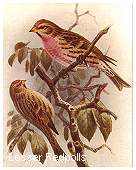 Canada
Geese seem to be well down in numbers, only a couple of nests were visible,
along with a pair of Great Crested Grebes, two Mute Swans and a very vocal
Little Grebe that has been present on every visit during the last couple of
weeks, so it could well be one of a pair. Blackcaps and Willow Warblers were in
song, but stars of the day were a flock of around 20 Lesser redpolls (C.f.
cabaret) bathing in the spring water bubbling up from near the pumping
station, unusual for this species they were very confiding and gave good views
as they treated themselves to a good soaking before flying just a few feet up
into the surrounding vegetation where they spent 10 minutes drying and preening
their feathers. Across in Mobberley three observers a keeping an eye on
Mobberley SQ where, on Friday of last week (20th), an overflying Whimbrel gave
good views before it was watched from Pavement Lane pass over Tatton Park and
away to the west, this was the first record since the flock of 9 on 9th May
1989 ( I shall of course be claiming this as a Tatton tick Bryan!!)
Canada
Geese seem to be well down in numbers, only a couple of nests were visible,
along with a pair of Great Crested Grebes, two Mute Swans and a very vocal
Little Grebe that has been present on every visit during the last couple of
weeks, so it could well be one of a pair. Blackcaps and Willow Warblers were in
song, but stars of the day were a flock of around 20 Lesser redpolls (C.f.
cabaret) bathing in the spring water bubbling up from near the pumping
station, unusual for this species they were very confiding and gave good views
as they treated themselves to a good soaking before flying just a few feet up
into the surrounding vegetation where they spent 10 minutes drying and preening
their feathers. Across in Mobberley three observers a keeping an eye on
Mobberley SQ where, on Friday of last week (20th), an overflying Whimbrel gave
good views before it was watched from Pavement Lane pass over Tatton Park and
away to the west, this was the first record since the flock of 9 on 9th May
1989 ( I shall of course be claiming this as a Tatton tick Bryan!!)
19/04/01 The "potato-dropper" as
Boyd referred to it returned yesterday to the area with
a male at Mobberley SQ, there were two present this morning along with half a
dozen
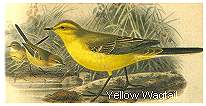 LBJ's that looked
very interesting but were too far away for a positive ID. Boyd's potato-dropper
is the Yellow Wagtail and received it's splendid nickname from Cheshire farmers
who also referred to it as the "potato-setter" and, as the name
implies, thought it prudent to refrain from planting their spuds until the bird
put in it's first appearance each Spring. Apparently Tatton Park is to be
re-opened next Wednesday (25th) - or more correctly - parts of it are, entry
will be via the Rostherne entrance only, so you'll have to pay. I don't think
there's much chance of Dog Wood and the mereside path towards the bathing area
being included though, the idea seems to to clear enough space for the Royal
Horticultural Societies' Show in July, understandable as this is the Park's
main annual earner.
LBJ's that looked
very interesting but were too far away for a positive ID. Boyd's potato-dropper
is the Yellow Wagtail and received it's splendid nickname from Cheshire farmers
who also referred to it as the "potato-setter" and, as the name
implies, thought it prudent to refrain from planting their spuds until the bird
put in it's first appearance each Spring. Apparently Tatton Park is to be
re-opened next Wednesday (25th) - or more correctly - parts of it are, entry
will be via the Rostherne entrance only, so you'll have to pay. I don't think
there's much chance of Dog Wood and the mereside path towards the bathing area
being included though, the idea seems to to clear enough space for the Royal
Horticultural Societies' Show in July, understandable as this is the Park's
main annual earner.
16/04/01 I remember a well respected birder once telling me that the only time he could be certain of the identification of a White Wagtail was when it was a male in Spring plumage. They are certainly easy to pick out, even at a distance with their ash grey back and jet black crown, nape and bib contrasting so strikingly with their white foreheads, faces and ear coverts. They pass through the area each Spring, presumably on their way to breeding grounds in Iceland, because they are reported as being more common in the west of the UK than the East. Three birds - all males, were present today at Mobberley SQ - viewable from the gate at the east side of the quarry, without having to stray onto the farmland. The Macmillan guide, when describing autumn plumages uses words like usually, some, disconcertingly, caution, may and probably although there are those who seem to have few problems in separating juveniles of both sub-species! Also today a flock of five Redwings over Knutsford, hurrying north, I think these will be the last we'll see until the Autumn.
12/04/01 An influx of Blackcaps, with singing males throughout the area today, two along Pavement Lane in Mobberley were recent arrivals this evening, they don't normally nest in that particular location. Jane Crossen had her first Willow Warbler this morning in her garden in Shaw Heath (Knutsford) we had our first two days earlier on Knutsford Moor. Of particular interest are the two Willow Tits currently visiting Jane's garden, this species is thought to be declining; not as fast as the Marsh Tit, but I've only seen one in the Knutsford area over the past five years.
08/04/01 No sooner had the electrons sped off into
Cyberspace carrying yesterday's update than an e-mail from Pete Hall arrived
carrying news of an earlier Blackcap
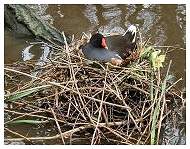 heard singing at Toft
on the more respectable date of April 1st! Pete reports an abundance of
Chiffchaffs this Spring and a visit to Toft Pool by a female Goosander. Over in
Mobberley yesterday the incessant rain continued for most of the day, there
were no flying insects for the 23 Sand Martins over the Sand Quarry and they
were reduced to taking food from the surface of the water, not very
energy-efficient but used a lot in poor weather especially during the Spring
migration. Accompanying the Sand Martins were two other hirrundines; House
Martins, the first of the year and 1 day earlier than the ten year rolling
average (for Tatton) calculated from data collected over the past 30 years. The
trip to lake Vyrnwy was cancelled, so today we travelled north to the WWT
Reserve
heard singing at Toft
on the more respectable date of April 1st! Pete reports an abundance of
Chiffchaffs this Spring and a visit to Toft Pool by a female Goosander. Over in
Mobberley yesterday the incessant rain continued for most of the day, there
were no flying insects for the 23 Sand Martins over the Sand Quarry and they
were reduced to taking food from the surface of the water, not very
energy-efficient but used a lot in poor weather especially during the Spring
migration. Accompanying the Sand Martins were two other hirrundines; House
Martins, the first of the year and 1 day earlier than the ten year rolling
average (for Tatton) calculated from data collected over the past 30 years. The
trip to lake Vyrnwy was cancelled, so today we travelled north to the WWT
Reserve
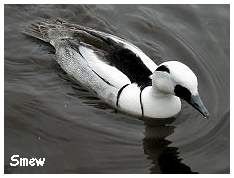 at Martin's Mere, an unusual time
of year for us, we normally do this trip in December just before Christmas
(giving everyone an opportunity to stock up on cards prior to the KOS Christmas
Party!). It might as well have been December though, it was perishing, and the
temperature at noon was only 6ºC. 500 Pink-footed Geese still remained,
together with a handful of last year's record breaking flock of Whooper Swans
and 50 Ruff rested on the long shingle spit in front of Miller's Bridge Hide,
now nicely refurbished (but no warmer!). We saw only two Spring migrants; a
lone Wheatear and a splendid Little Gull, just coming into Summer plumage, the
log sheets in the main building indicate Swallows, Sand Martins and Little
Ringed Plovers had all been picked out during the past few days. A good deal of
work seems to have been done on the pens with better fencing and fancy
"thematic?" entrances to the various geographical sections, some
birds had young and the most common nester were the Moorhens with one or two
pairs in every pen! These images were taken today on John's digital camera (1.3
mega pixels) not bad are they?
at Martin's Mere, an unusual time
of year for us, we normally do this trip in December just before Christmas
(giving everyone an opportunity to stock up on cards prior to the KOS Christmas
Party!). It might as well have been December though, it was perishing, and the
temperature at noon was only 6ºC. 500 Pink-footed Geese still remained,
together with a handful of last year's record breaking flock of Whooper Swans
and 50 Ruff rested on the long shingle spit in front of Miller's Bridge Hide,
now nicely refurbished (but no warmer!). We saw only two Spring migrants; a
lone Wheatear and a splendid Little Gull, just coming into Summer plumage, the
log sheets in the main building indicate Swallows, Sand Martins and Little
Ringed Plovers had all been picked out during the past few days. A good deal of
work seems to have been done on the pens with better fencing and fancy
"thematic?" entrances to the various geographical sections, some
birds had young and the most common nester were the Moorhens with one or two
pairs in every pen! These images were taken today on John's digital camera (1.3
mega pixels) not bad are they?
07/04/01 Thanks to Bryan Roberts who sends news of the
first singing Blackcap of the Year, seen and heard on Friday (6/04) outside the
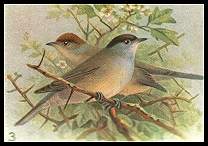 Knutsford gate of Tatton Park,
almost two weeks later than last year's first bird recorded on the 22nd March
in Mobberley. The foot-and-mouth restrictions are continuing to cause problems
with most farmland off limits to the majority of people, but it does mean that
some areas normally getting only a cursory glance are currently being visited
more frequently. Bryan tells of a birder in Woodford having two new
"ticks" on his 10K square over the last week with Ruff and
Black-tailed Godwit on a flooded field (plus Little Ringed Plover and
Oystercatcher). Here in Mobberley the local sand quarry is getting plenty of
attention, so far with little success, although the two Shelducks that now
appear to be permanent fixtures were joined once again by a Ruddy Shelduck of
unknown pedigree! Yesterday morning two Swallows passed through along with
large numbers of Sand Martins, on this day last year there were 600+ of the
latter over Tatton Mere.
Knutsford gate of Tatton Park,
almost two weeks later than last year's first bird recorded on the 22nd March
in Mobberley. The foot-and-mouth restrictions are continuing to cause problems
with most farmland off limits to the majority of people, but it does mean that
some areas normally getting only a cursory glance are currently being visited
more frequently. Bryan tells of a birder in Woodford having two new
"ticks" on his 10K square over the last week with Ruff and
Black-tailed Godwit on a flooded field (plus Little Ringed Plover and
Oystercatcher). Here in Mobberley the local sand quarry is getting plenty of
attention, so far with little success, although the two Shelducks that now
appear to be permanent fixtures were joined once again by a Ruddy Shelduck of
unknown pedigree! Yesterday morning two Swallows passed through along with
large numbers of Sand Martins, on this day last year there were 600+ of the
latter over Tatton Mere.
31/03/01 The majority of our Winter Thrushes seem to have left us, all week flocks of (mainly) Redwings have been passing through the area in a northerly direction, I saw none today during a two hour walk round the lanes of Mobberley. From Slade Lane a Sparrowhawk and a pair of Buzzards could be seen floating round in the thermals over Tatton Park which still remains closed due to the foot-and-mouth restrictions, three Lapwings were on eggs on a rough pasture alongside Smith Lane and two Swallows were hawking for insects in the distance over Broad Oak Farm, they seen early this year, in Toft Pete Hall recorded the first returning bird on the 28th his earliest ever record. A rare moment of relief for Pete who reports that the dreaded F&M has been discovered in sheep just across the fields in Peover.
24/03/01 An e-mail from Bryan Roberts reports 30 Sand Martins over Tatton Mere on Thursday (22nd), accompanying them the first Swallow of the year, the same date as last year. On Knutsford Moor he had the first singing Chiffchaff, probably the same bird we heard the following day. The trip on the 8th. April to Lake Vyrnwy has been replaced by a visit to Martin's Mere, assuming it's still open - the Reserve is re-opening this weekend. The long weekend to Barmouth in May will go ahead whatever the prevailing F&M situation, all participants agreed to this at last night's monthly indoor meeting - incidently this was one of the best we'd enjoyed for a long time, Andy Harmer'simages are quite breathtaking and when combined with his authoritative but highly amusing comments the end product is a truly memorable evening.
19/03/01 The current restrictions are keeping the
"Thursday Club" in alien
territory, ie below the 1000' contour, in fact last week's walk took place at
sea level and on the flat - just up my street!
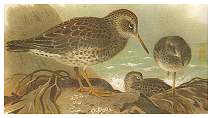 So I joined them on a
stroll from West Kirby out to Hilbre and back, about as far from cloven hoofed
animals as it's possible to get! We were greeted by a lone Fulmar circling the
Islands, this is quite a rare species for Hilbre, the latest
Cheshire Bird
Report (1999) has only two Winter records. Apart from an abundance of
Oystercatchers we saw few birds until we approached the north east corner of
the island where we rewarded with fine views of a flock of 19 pale-bellied
Brent Geese resting on the rocky foreshore, they move onto the water and
floated slowly away on the incoming tide leaving an interesting selection of
waders - Redshanks, Knot, Dunlin and a handful of Purple Sandpipers - a species
we sometimes catch on the annual September trip but never seem to get a decent
look at. We didn't sit out the tide today but made our way back to West Kirby
for an excellent lunch in "The Ring of Bells" ( Steak and Kidney pie
£3.95 and a good selection of draught bitters).
So I joined them on a
stroll from West Kirby out to Hilbre and back, about as far from cloven hoofed
animals as it's possible to get! We were greeted by a lone Fulmar circling the
Islands, this is quite a rare species for Hilbre, the latest
Cheshire Bird
Report (1999) has only two Winter records. Apart from an abundance of
Oystercatchers we saw few birds until we approached the north east corner of
the island where we rewarded with fine views of a flock of 19 pale-bellied
Brent Geese resting on the rocky foreshore, they move onto the water and
floated slowly away on the incoming tide leaving an interesting selection of
waders - Redshanks, Knot, Dunlin and a handful of Purple Sandpipers - a species
we sometimes catch on the annual September trip but never seem to get a decent
look at. We didn't sit out the tide today but made our way back to West Kirby
for an excellent lunch in "The Ring of Bells" ( Steak and Kidney pie
£3.95 and a good selection of draught bitters).
14/03/01 The Foot-and-Mouth epidemic shows no sign of abating, we had the first case of the disease in Cheshire today - sheep in the Nantwich area. As with most other cases it seems to have been caused by animals brought in from the North-east of England, the source of the original infection. All public footpaths across farmland have been closed, and as a consequence our activities are being severely restricted, the only places accessible locally, apart from the roadside seem to be Knutsford Moor and Mobberley Sand Quarry (SQ), where there are no cattle and it's possible to view the area from the road. At the last location two Oystercatchers have recently taken up residence, whilst further down the road along Smith Lane good numbers of Lapwings are setting up territories alongside a few Skylarks, who's population should increase as the Spring progresses. At the bottom end of the Lane in an old Black Poplar (I don't think it's a "real" one) there's a traditional Tawny Owl site where they've nested at least 20 years, to my knowledge. On Winter afternoons one of the birds was often to be seen enjoying the warmth of the sun, it's face clearly visible at the entrance to the nest site, I presume they now have eggs as we've not seen either bird for some days - they are known to be early nesters and the female bird begins incubation immediately the first egg is laid.
09/03/01 A close finish to the Sand Martin Competition with the winner having a slot of only 30 minutes to herself! Nevertheless, congratulations to Hazel Raw who's guess of 11:45 on 9/3 was only 15 minutes out, the first bird was seen today over Tatton Mere by Ranger, Darren Morris at 11:30 am Commiserations to Alf Caldwell (11:00am) and Jean Brookes (12noon) and also Martin, Paul and Ken who all got the correct day! Spring has officially arrived in Knutsford!
07/03/01 A dramatic change in the weather has taken place over the past 24 hours. After a settled period of ten days or so with high barometric pressure and easterly winds, we now have a current outside temperature of 14ºC, in contrast to recent daytime highs of only three or four degrees. As the wind changed direction we had a few hours of very strong gusts, this always scatters a sprinkling of seeds beneath the Alder trees on Knutsford Moor and invariably encourages any Finches present to feed on the ground rather from the trees themselves. This proved to be the case today and a mixed flock of some 40 birds, Goldfinches, Chaffinches, Siskins and Lesser Redpolls gave us excellent views, against a dark background, rather than the usual tree top silhouettes. No sign so far of any Sand Martins although they have arrived in the south of England and can't be too far away!
04/03/01 The continuing spread of Foot and Mouth disease
is causing major disruption to life in the British countryside, for many
Farmers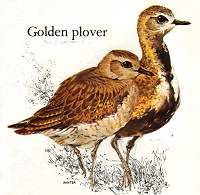 it may
prove to be the "final straw" and everyone is doing their best to
prevent it's spread. All public parks and footpaths are closed, so for many
birders activities are severely restricted. Locally Tatton Park is closed (
thankfully Knutsford Moor and Dog Wood are not included), we are asked not to
go onto farmland, although there seems to be no problem with birding from the
roadside. In the distance from along Pavement Lane in Mobberley we could see
that the local Lapwings had returned and four pairs were noted, there was some
display on a brilliant late Winter morning despite the temperature still
remaining well below zero and the birds took it in turn to chase off a Buzzard
that had strayed into their territory from nearby woodland. At the other end of
the village Lapwings from further afield flocked with a small group of Golden
Plovers, many now sporting their Summer plumage. Over the same field the first
singing Skylark of the year, a tiny dot in the sky had to take immediate
evasive action to avoid being sucked into the engine of a landing
PIA Jumbo heading
for the new runway at Manchester Airport - I kid you not!
it may
prove to be the "final straw" and everyone is doing their best to
prevent it's spread. All public parks and footpaths are closed, so for many
birders activities are severely restricted. Locally Tatton Park is closed (
thankfully Knutsford Moor and Dog Wood are not included), we are asked not to
go onto farmland, although there seems to be no problem with birding from the
roadside. In the distance from along Pavement Lane in Mobberley we could see
that the local Lapwings had returned and four pairs were noted, there was some
display on a brilliant late Winter morning despite the temperature still
remaining well below zero and the birds took it in turn to chase off a Buzzard
that had strayed into their territory from nearby woodland. At the other end of
the village Lapwings from further afield flocked with a small group of Golden
Plovers, many now sporting their Summer plumage. Over the same field the first
singing Skylark of the year, a tiny dot in the sky had to take immediate
evasive action to avoid being sucked into the engine of a landing
PIA Jumbo heading
for the new runway at Manchester Airport - I kid you not!
26/02/01 37 entries for this year's Sand Martin competition, featuring a range of no less than 27 days, starting with a very optimistic 23/02 from Colin right through to Keith's estimate of 21/03. Having said that Colin gets a couple of days to himself before Bill would be closest! As last year, individual ranges fall to less than an hour during the most popular dates, between the 11th and 14th. The current outbreak of Foot and Mouth disease is complicating matters somewhat because Tatton Park has been closed for the duration! Luckily Knutsford Moor is not included, and as the Sand Martins roost there, the first birds won't go unrecorded, although late pm entries will be favoured.
Entries for the KOS 2001 Sand Martin Competition.
| 23/02/01 | 11:00 | Colin Jacobs | |
| 29/02/01 | 11:16 | Bill Alexander | |
| 06/03/00 | 10:24 | Andy | Leigh |
| 07/03/01 | 09:30 | Sue Grassby | Allostock |
| 07/03/01 | 12:00 | Andy Mabbett | Birmingham? |
| 07/03/01 | 17:30 | Bob Groom | Knutsford |
| 08/03/01 | 11:00 | John Grassby | Allostock |
| 08/03/01 | 14:00 | Karl Johnson | |
| 09/03/01 | 09:40 | Martin Adlam | |
| 09/03/01 | 10:05 | Paul Hill | Crewe |
| 09/03/01 | 11:00 | Alf Caldwell | Altrincham |
| 09/03/01 | 11:45 | Hazel Raw | Knutsford |
| 09/03/01 | 12:00 | Jean Brookes | Knutsford |
| 09/03/01 | 15:47 | Ken Wakefield | Belgium |
| 10/03/01 | 08:30 | Paul Rooney | Widnes |
| 10/03/01 | 09:15 | Elizabeth Perkins | Knutsford |
| 10/03/01 | 18:30 | Jane Crossen | Knutsford |
| 11/03/00 | 08:20 | Len Mason | Mobberley |
| 11/03/01 | 08:50 | Ian Lescure | Maybole, Ayrshire |
| 11/03/01 | 10:10 | Jill Thornley | Appleton Thorn |
| 11/03/01 | 10:30 | Edward Rickson | Kópavogur Iceland |
| 11/03/01 | 12:00 | Adam Davison | Sale |
| 11/03/01 | 12:35 | Brian Raw | Knutsford |
| 12/03/01 | 15:00 | Peter Perkins | Knutsford |
| 12/03/01 | 15:55 | John Wood | |
| 13/03/01 | 09:55 | John Somerville | Sale |
| 13/03/01 | 11:15 | Jean Emsley | Knutsford |
| 13/03/01 | 18:30 | Derek Pike | Knutsford |
| 14/03/01 | 09:15 | Roy Bircumshaw | Knutsford |
| 14/03/01 | 09.45 | Helen Thornley | Cambridge |
| 14/03/01 | 14:30 | Pete Hall | People's Republic of Toft |
| 14/03/01 | 17:15 | Terry Heath | Knutsford |
| 15/03/01 | 11:00 | Helen Thorne | Holmes Chapel |
| 15/03/01 | 11:15 | Sheila Blamire | Mere |
| 16/03/01 | 14:25 | Sue Heath | Knutsford |
| 17/03/01 | 17:30 | Frank Dearden | Knutsford |
| 20/03/01 | 10:30 | Jim McHarry | Knutsford |
| 21/03/00 | 12:00 | Keith Seaton | Altrincham |
20/02/00 A cool, misty morning for our third and final visit this Winter to Marthall for the BTO Wintering Farmland Birds Survey. Predictably there was quite a bit of song with Chaffinches, Dunnocks and Song Thrushes all in good voice, there were an encouraging number of the latter in evidence, also Yellow Hammers - we noted three singing males on our 1 kilometer square. At one point a Tree Sparrow passed overhead calling loudly, this is becoming quite scarce now of course, although a pair are again in residence along Pavement Lane in Mobberley and our Chairperson has had more than 40 in the Garden this Winter! Many species are now pairing off and a pair of Magpies were adding the final touches to a well concealed nest near the top of a roadside conifer tree. Winter visitors are still with us in large numbers, currently Redwings are the most numerous, on one field a massive flock of c. 250 birds were counted, accompanied by only a handful of Fieldfares.
14/02/01 From that well known Man.U. fan - John
Somerville!........Wednesday evening 14th February and a right lot of
rubbish on the TV so I thought that I would list some of the recent sightings
on Carrington Moss.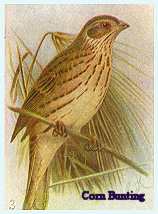 Two
friends of mine along with the Director of the Cheshire Wildlife Trust were
invited by Manchester United to inspect and comment on their 10 acre nature
reserve which is about 200 yards from their new training ground.
Two
friends of mine along with the Director of the Cheshire Wildlife Trust were
invited by Manchester United to inspect and comment on their 10 acre nature
reserve which is about 200 yards from their new training ground.
The nature reserve was riddled with Vole holes and within a few yards after
entering the site a Short Eared Owl rose from the ground. This could be, if
properly managed, an excellent reserve for birds with a reasonable sized pool
containing three islands. The pools within the old sewage beds belonging to
North West Water have always been good for ducks with large numbers of Teal,
Shoveller, Gadwall and Mallard but a female Goldeneye made a nice change. The
rides in the Moss contain plenty of small birds and tits abound especially Blue
Tit, Great Tit and Long- tailed Tit but some excellent sightings of Willow Tit
were especially appreciated.
To finish of a good walk a singing Corn Bunting was very welcome. The Corn
Bunting was a common bird on the Moss in past years but not now. If the plans
by Shell to build on 350 acres of the Moss including a huge transport depot are
passed then this will be another massive blow to those open farmland birds such
as Skylark, Lapwing, Partridge and Corn Bunting.... JS
04/02/01 Rostherne Mere always used to be the place to
see Goosanders, during the Winter months one could almost always find small
gatherings of up to 25 birds to the right of the Oservatory in the shallows in
front of Shaw Green Willows. The Shropshire Meres could also be relied upon,
especially Doddington, where an old notebook mentions them on 3rd. March 1973
during a pre- KOS trip with Bill Mulligan
and the WEA class.
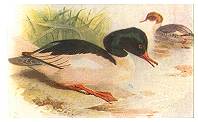 On a
Thursday Group walk a couple of years
ago we had a flock of 40 birds on a small pool in Cholmondely Park in the south
of Cheshire, so the species is regular in good numbers to the south of us, but
currently rarely seen on local waters. It was a pleasant surprise therefore to
discover a female bird today on Knutsford Moor, it seemed quite settled and
unconcerned by the non-stop activity of a group of 30 or so Teal in their own
characteristic Springtime perpetual motion mode. Nearby, in Dog Wood Blue and
Great Tits were exploring potential nest sites, Nuthatches were very vocal and
at least three Great Spotted Woodpeckers were "drumming" loudly and
occasionally coming noisily to blows as they fought to establish breeding
territories.
On a
Thursday Group walk a couple of years
ago we had a flock of 40 birds on a small pool in Cholmondely Park in the south
of Cheshire, so the species is regular in good numbers to the south of us, but
currently rarely seen on local waters. It was a pleasant surprise therefore to
discover a female bird today on Knutsford Moor, it seemed quite settled and
unconcerned by the non-stop activity of a group of 30 or so Teal in their own
characteristic Springtime perpetual motion mode. Nearby, in Dog Wood Blue and
Great Tits were exploring potential nest sites, Nuthatches were very vocal and
at least three Great Spotted Woodpeckers were "drumming" loudly and
occasionally coming noisily to blows as they fought to establish breeding
territories.
24/01/01 The cold snap lasted for more than two weeks,
sub-zero temperatures at night followed by mainly sunny days with the
temperature rising to just a few degrees above zero. The fields in Mobberley
dried out quickly giving our nearest farmer chance to plough 30 acres and sow
his Winter Barley at long last, but at the other side of the village whilst
they were also able to get their tractor onto the beet field the crop had
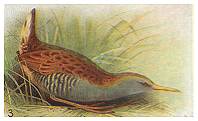 frozen into the ground, so it
still had to be lifted by hand! In a pasture next to the beet we noticed a
small flock of 10 Lapwings accompanied by no less than 44 Golden Plovers, these
birds used to roost a couple of miles away at Ringway but the traditional site
has been covered by the new runway and I've not seen a flock this big for a
number of Years. Tatton Mere all but froze over completely, only a few square
yards on the west side remained free of ice and attracted a large concentration
of wildfowl, mainly Mallard, Tufted Ducks and Mute Swans. A Kingfisher flew low
over Knutsford Moor but was unable to find any open water and made off towards
the Birkin, whilst in the Alders surrounding the Moor the more usual Siskins
were joined by a flock of c.40 Lesser Redpolls, a high count for a species that
seems to have declined considerably of late. A spring surfacing on the Moor,
close to the Pumping Station never freezes no matter how cold it gets, it runs
for only about 150 yards before running into the main Mere and is the most
reliable site in the area for Water Rails, forced out of the reeds in their
search for food during periods of very cold weather, we counted five birds on
one particularly frigid morning.
frozen into the ground, so it
still had to be lifted by hand! In a pasture next to the beet we noticed a
small flock of 10 Lapwings accompanied by no less than 44 Golden Plovers, these
birds used to roost a couple of miles away at Ringway but the traditional site
has been covered by the new runway and I've not seen a flock this big for a
number of Years. Tatton Mere all but froze over completely, only a few square
yards on the west side remained free of ice and attracted a large concentration
of wildfowl, mainly Mallard, Tufted Ducks and Mute Swans. A Kingfisher flew low
over Knutsford Moor but was unable to find any open water and made off towards
the Birkin, whilst in the Alders surrounding the Moor the more usual Siskins
were joined by a flock of c.40 Lesser Redpolls, a high count for a species that
seems to have declined considerably of late. A spring surfacing on the Moor,
close to the Pumping Station never freezes no matter how cold it gets, it runs
for only about 150 yards before running into the main Mere and is the most
reliable site in the area for Water Rails, forced out of the reeds in their
search for food during periods of very cold weather, we counted five birds on
one particularly frigid morning.
16/01/01 Superb weather for our first trip as a Society
to Blackpool's Marton Mere Local Nature Reserve, cold and frosty but dry with
unbroken sunshine all day. The Reserve is owned and managed by Blackpool
Borough Council and covers 40 hectares encompassing within it's boundaries the
largest natural lake in the County of Lancashire.
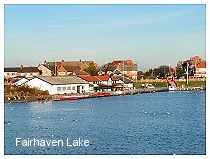 The Visitor Center
was not open but the hides were all accessible and a well stocked feeding
station was attracting substantial numbers of passerines - Blue, Great and
Long-tailed Tits, Chaffinches and Goldfinches. On the Mere itself were plenty
of Teal, Mallard and Tufted Ducks, with single figure counts of Gadwall,
Pochard and Goldeneye. From the path at the east side of the Mere, just off the
Reserve with a few Mute we noted 8 Bewick's Swans, close by on the ground a
Peregrine Falcon was devouring a recently caught victim. All morning large
flocks of Pink-footed Geese were passing to and fro over the Reserve -
reminding us that we weren't too far from their main stronghold around the
Southport area. The Long-eared Owls wintering at Marton had not read the script
and failed to appear as predicted, no sign either of the local Water Rails or
the overwintering Bittern, so we moved a short distance South to the town of
Lytham and Fairhaven Lake, a very civilised location and obviously popular with
local residents who were enjoying their afternoon stroll in the bright Winter
sun round the perimeter. On the water we had fine views of six Red-breasted
Mergansers, two Scaup and a rare male Ferruginous Duck which was quite
unconcerned by the constant stream of folk arriving to have a look at it, it
spent some time out of the water on one of the islands in the center of the
lake where we could see that it was un-ringed and so possibly a
"genuine" wild bird.
The Visitor Center
was not open but the hides were all accessible and a well stocked feeding
station was attracting substantial numbers of passerines - Blue, Great and
Long-tailed Tits, Chaffinches and Goldfinches. On the Mere itself were plenty
of Teal, Mallard and Tufted Ducks, with single figure counts of Gadwall,
Pochard and Goldeneye. From the path at the east side of the Mere, just off the
Reserve with a few Mute we noted 8 Bewick's Swans, close by on the ground a
Peregrine Falcon was devouring a recently caught victim. All morning large
flocks of Pink-footed Geese were passing to and fro over the Reserve -
reminding us that we weren't too far from their main stronghold around the
Southport area. The Long-eared Owls wintering at Marton had not read the script
and failed to appear as predicted, no sign either of the local Water Rails or
the overwintering Bittern, so we moved a short distance South to the town of
Lytham and Fairhaven Lake, a very civilised location and obviously popular with
local residents who were enjoying their afternoon stroll in the bright Winter
sun round the perimeter. On the water we had fine views of six Red-breasted
Mergansers, two Scaup and a rare male Ferruginous Duck which was quite
unconcerned by the constant stream of folk arriving to have a look at it, it
spent some time out of the water on one of the islands in the center of the
lake where we could see that it was un-ringed and so possibly a
"genuine" wild bird.
11/01/01 There has been a large influx of Waxwings into the Country over the last couple of weeks, some have made it to the West and have been reported in small numbers from here in Cheshire. A report today of a number earlier this week in a Knutsford garden, whilst yesterday in Mobberley an unidentified flock of birds flying into berry-bearing bushes at Barclay Hall will be investigated first thing this morning - well they will be when Len's had his first brew!!
10/01/01 There are some pretty fancy motorcycles to be seen on the roads nowadays, rarely seen out in the Winter months and piloted predominately by ageing "baby boomers" reluctant to accept their inevitable decline into middle age and probably the only people able to afford the initial cost and ongoing maintenance charges for these complex and increasingly sophisticated warhorses. It wasn't always like this, back in the 60's 'bikes were the only affordable mode of transport for many and the excellent monthly "Motor Cycle Mechanics" could be relied upon for hints and tips on how to keep that oldBonneville or Francis Barnet on the road for all 12 months of the year. This is the start of the sixth year in cyberspace for the KOS Website and I'm conscious of a parallel with this section and some parts of MCM - it's a bit "samey" or repetitious on an annual basis. Come October - just as we get the first Redwings and Fieldfares MCM could be relied upon to fill four pages with the usual article on preparing your machine for the coming Winter months and later, perhaps in November tips about riding in snow and ice - just at the time our "Latest News" reports the first flock of Pinkfeet heading into the morning sun towards the Pennines! For Birders Spring brings the return of our regular migrants returning from the south, whilst the old MCM would be listing the appropriate checks to ensure another six month of trouble free Summer riding. It's perhaps all a bit too predictable - but within this rigid framework, dictated largely by our weather we can sometimes detect subtle variations, both short and long-term, so in addition to the obvious attractions of the now easily affordable (for some!!) exotic birding destinations it's important not to neglect our own backyards where local bird clubs can have such an important role in monitoring the well being of their own environments. Then of course just as our Motor Cycling friends have fond memories of those special days - the traffic-free early morning blast through Macclesfield and on over the "Cat & Fiddle" perhaps, then so we can look forward to our own highlights, like last year's Common Crane in Mobberley and the amazing sight of the in-flight food pass between adult and juvenile Hobbies right over the center of the same village. So we'll wheel this particular vehicle out of the garage again and head off into Ornithological cyberspace for another year, attempting to avoid too much in the way of repetition but remaining conscious of the fact that Nature itself relies on annual cycles, whilst throwing up random anomalies to keep us all on our toes!
29/12/00 We had the heaviest snow storm for many years
during the early morning of the 28th. I measured a depth of 95mm (4") at
9.00am and it was still falling then.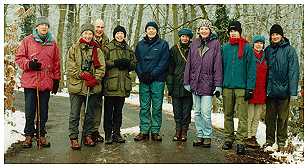 Temperatures have not risen much above freezing since and at a
location in Shropshire, which is just to the south of us, -13ºC was
recorded last night. We're not too far behind, the current reading in Mobberley
at 10.00pm is -9ºC. So we have extensive snow cover that's not melting,
and in consequence huge numbers of Redwings, Fieldfares and Blackbirds are
moving into gardens, on the annual Christmas walk today every Hawthorn and
Holly bush seemed to contain several members of the Thrush family taking full
advantage of a good crop of berries. Budworth Mere was partially frozen and
most of the wildfowl that were noted here last week appeared to have moved off,
although it wasn't possible to see the far side too clearly due to the
persistent fog that stayed with us for most of the morning. The woodland bird
table had been freshly stocked with seed and there was a steady stream of
passerines mainly Blue, Great and Coal Tits but also Nuthatches and plenty of
Chaffinches. It was fortunate that we were well wrapped up because the
"George" at Great Budworth, whilst having most of the attributes
associated with a typical English pub, comfy seats, gleaming horse brasses and
bulls-eye windows etc. had failed to provide the roaring log fire to complete
the picture, in fact it was bloody freezing! Nevertheless the food was
excellent and the steak and ale pie is highly recommended! On the subject of
food, I did 36 jacket potatoes for this year's Christmas
Party which took place on the 15th. of the month, they all went first time
round so it was a good turn out this year, despite the absence of one or two
regulars. Thanks to all who contributed to another successful evening, which
probably means everyone there, it really is a team effort, with people either
bringing food or organising one of the games or quizzes!
Temperatures have not risen much above freezing since and at a
location in Shropshire, which is just to the south of us, -13ºC was
recorded last night. We're not too far behind, the current reading in Mobberley
at 10.00pm is -9ºC. So we have extensive snow cover that's not melting,
and in consequence huge numbers of Redwings, Fieldfares and Blackbirds are
moving into gardens, on the annual Christmas walk today every Hawthorn and
Holly bush seemed to contain several members of the Thrush family taking full
advantage of a good crop of berries. Budworth Mere was partially frozen and
most of the wildfowl that were noted here last week appeared to have moved off,
although it wasn't possible to see the far side too clearly due to the
persistent fog that stayed with us for most of the morning. The woodland bird
table had been freshly stocked with seed and there was a steady stream of
passerines mainly Blue, Great and Coal Tits but also Nuthatches and plenty of
Chaffinches. It was fortunate that we were well wrapped up because the
"George" at Great Budworth, whilst having most of the attributes
associated with a typical English pub, comfy seats, gleaming horse brasses and
bulls-eye windows etc. had failed to provide the roaring log fire to complete
the picture, in fact it was bloody freezing! Nevertheless the food was
excellent and the steak and ale pie is highly recommended! On the subject of
food, I did 36 jacket potatoes for this year's Christmas
Party which took place on the 15th. of the month, they all went first time
round so it was a good turn out this year, despite the absence of one or two
regulars. Thanks to all who contributed to another successful evening, which
probably means everyone there, it really is a team effort, with people either
bringing food or organising one of the games or quizzes!
25/12/00 Well, there wasn't a lot of it about and it didn't stick, but it did definitely snow for a short time this morning, enough to give Pavement Lane in Mobberley a seasonal dusting and our first "white Christmas" for some years! Song and Mistle Thrushes have been in song intermittently for some weeks now, they were joined today by the local Dunnocks, nothing too serious, just a few short blasts from the hedge tops as they paused for a few moments during the business of foraging in the hedge bottoms, an activity that seems to occupy them for most of the day at this time of the year. Two Pink-footed Geese flew over in the general direction of the Pennines, I suspect that one reason some species normally move about in large flocks is that individually they don't have a very good sense of direction, so the more individuals there are in a group the more accurate their navigation becomes. Today's pair, whilst moving steadily east were meandering along, constantly having to readjust their path, a flock of around a 100 birds which is more common deviate very little and appear to know exactly where they're going.
Back to Knutsford Ornithological Society Homepage